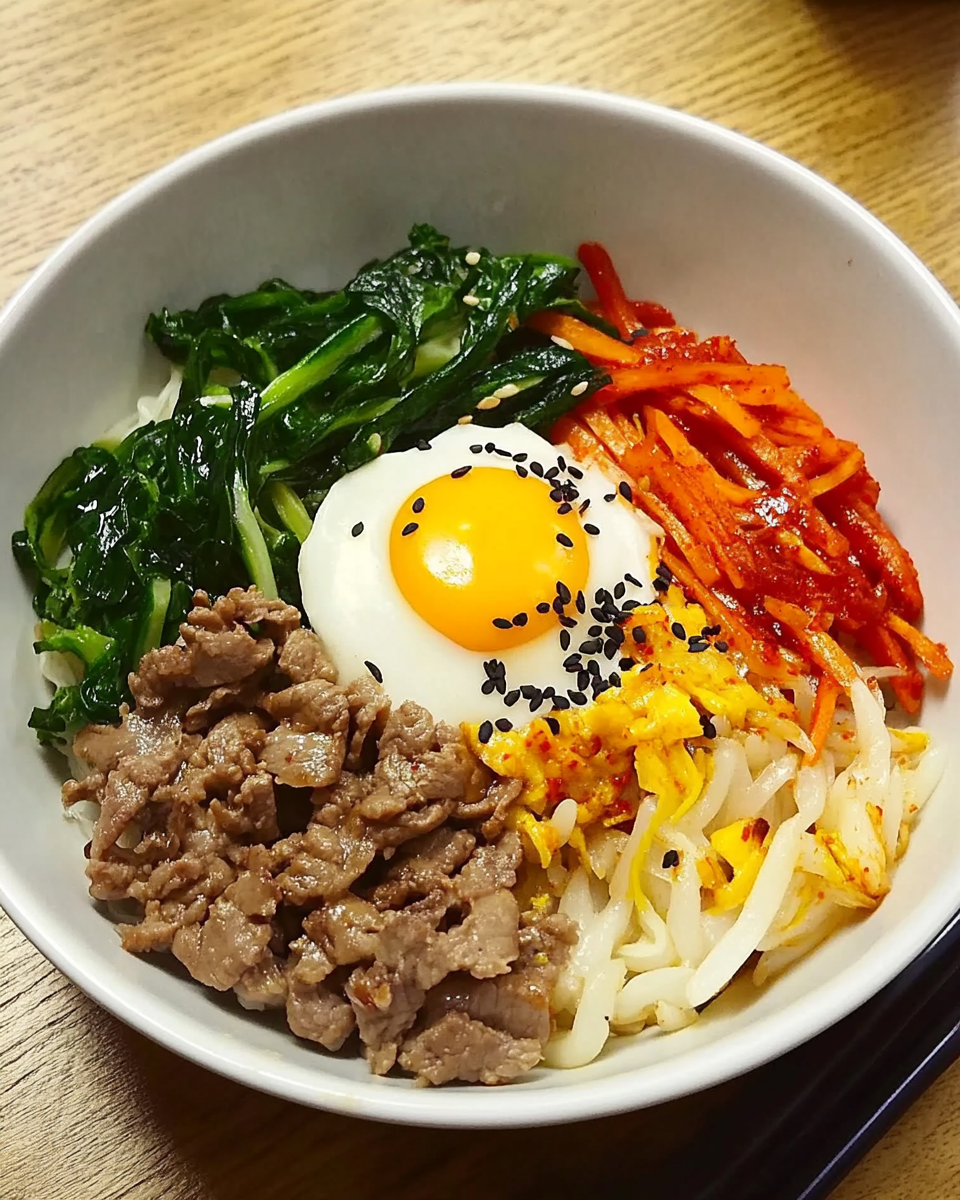Bibimbap, a beloved Korean dish, has captured the hearts of food enthusiasts worldwide. Known for its vibrant colors, balanced flavors, and nutritious ingredients, Bibimbap is a meal that satisfies both the eyes and the palate. The word “Bibimbap” literally translates to “mixed rice,” which perfectly describes this dish’s core concept. It is traditionally served as a bowl of warm white rice topped with a variety of seasoned vegetables, sliced meat (often beef), a fried egg, and gochujang (Korean chili paste). The dish is then mixed thoroughly before eating, combining all the ingredients into a harmonious blend of flavors and textures.
The Origins of Bibimbap
The history of Bibimbap is deeply rooted in Korean culture. It is believed to have originated as a simple farmer’s meal. During the harvest season, farmers would combine leftover vegetables, rice, and sometimes meat into a single bowl for convenience and sustenance. Some historians also suggest that Bibimbap was created as a way to use up leftover food on New Year’s Eve, in order to start the new year fresh, without any remnants of the previous year’s meals.
Over time, Bibimbap has evolved into a popular dish served in both casual and fine dining restaurants, enjoyed by people of all backgrounds. It has also become an iconic representation of Korean cuisine, showcasing the country’s focus on balance and harmony, both in terms of nutrition and flavor.
Key Ingredients and Their Nutritional Benefits
Bibimbap is not only delicious but also incredibly nutritious. Each component of the dish contributes to its overall health benefits, making it a well-rounded and wholesome meal.
- Rice: The base of Bibimbap is steamed white rice, which provides the carbohydrates necessary for energy. In modern adaptations, brown rice or other grains can be used for a more fiber-rich and nutrient-dense option.
- Vegetables: A key feature of Bibimbap is the variety of vegetables used. These typically include carrots, spinach, zucchini, mushrooms, and bean sprouts, all of which add essential vitamins, minerals, and antioxidants. The vegetables are lightly seasoned and cooked to retain their nutritional value.
- Protein: Beef is the traditional protein in Bibimbap, usually marinated in a mixture of sesame oil, garlic, and soy sauce, which adds depth of flavor. However, chicken, pork, tofu, or even seafood can be substituted, making the dish adaptable to various diets, including vegetarian and vegan options.
- Egg: The fried egg on top is more than just a garnish. It adds a rich texture and flavor to the dish. The runny yolk acts as a natural sauce when mixed with the other ingredients, adding creaminess to the overall dish. Eggs also provide a good source of protein, vitamins, and healthy fats.
- Gochujang: This fermented chili paste is a crucial component of Bibimbap, providing the signature spicy kick. It is made from red chili powder, glutinous rice, fermented soybeans, and salt. Gochujang is not only flavorful but also packed with probiotics, which are beneficial for gut health.
- Sesame Oil and Seeds: Sesame oil is often drizzled over the finished dish, lending a nutty aroma and taste. Sesame seeds are also sprinkled on top, adding texture and an additional source of healthy fats and minerals.
A Visual and Sensory Feast
One of the most appealing aspects of Bibimbap is its presentation. The dish is usually served in a large bowl with the ingredients artfully arranged on top of the rice in colorful sections, before being mixed together by the diner. This vibrant display of colors—from the greens of the spinach and zucchini, to the orange of the carrots, to the red of the gochujang—creates an inviting visual that enhances the dining experience.
The sensory experience continues with the act of mixing. The contrast of textures, from the crisp vegetables to the tender meat and soft rice, makes every bite exciting. The combination of flavors—sweet, savory, spicy, and nutty—creates a well-balanced meal that appeals to a wide range of tastes.
Customization and Adaptability
One of the reasons Bibimbap has gained such widespread popularity is its versatility. The dish can easily be customized to suit different dietary preferences and ingredient availability. For instance, vegetarians can omit the meat and add tofu or extra vegetables, while vegans can skip the egg or use a plant-based alternative.
Bibimbap can also be adjusted to fit seasonal ingredients. In the summer, you might use fresh, raw vegetables, while in the winter, heartier vegetables like kimchi or roasted root vegetables can be added. The rice base can also be substituted with other grains such as quinoa or cauliflower rice for a lower-carb option.
Additionally, Bibimbap can be made gluten-free by using tamari instead of soy sauce and ensuring that all other seasonings, particularly gochujang, are free from gluten. The dish’s ability to accommodate various dietary needs makes it an inclusive and adaptable option for any meal.
Variations of Bibimbap
Though the basic structure of Bibimbap remains consistent, there are several regional and modern variations of the dish. One of the most well-known is Dolsot Bibimbap, which is served in a hot stone bowl. The bowl is heated until it is sizzling, and when the rice is added, it forms a crispy, golden crust on the bottom. This adds an extra layer of texture and flavor to the dish, making it a favorite among many Bibimbap lovers.
Another variation is Jeonju Bibimbap, named after the city of Jeonju, which is famous for its Bibimbap. This version often includes more luxurious ingredients, such as raw beef and a wider variety of vegetables, making it a special dish that’s often reserved for celebrations.
In more recent times, chefs have begun to experiment with Bibimbap, incorporating ingredients from other cuisines. For example, you might find fusion versions that include Mexican or Mediterranean flavors, such as adding avocado, feta cheese, or roasted red peppers to the mix. These modern takes on Bibimbap highlight the dish’s flexibility and ability to evolve with global food trends.
Cultural Significance of Bibimbap
Beyond its culinary appeal, Bibimbap holds significant cultural value in Korea. It is often enjoyed during family gatherings and special occasions. The communal nature of the dish—where each diner personalizes their bowl and mixes it themselves—mirrors the importance of togetherness and harmony in Korean culture.
The dish also embodies the Korean philosophy of “balance” in life. Bibimbap represents balance not only in its combination of different ingredients but also in its attention to taste, color, and nutrition. The five main colors in Korean cuisine—green, red, yellow, white, and black—are thought to represent the five elements (wood, fire, earth, metal, and water) and are believed to bring balance to the body when consumed in harmony.
Conclusion
Bibimbap is much more than just a meal; it’s an experience that brings together flavor, nutrition, and culture. Its vibrant colors and variety of ingredients make it a feast for the senses, while its adaptability allows it to be enjoyed by people with diverse dietary preferences. Whether you’re enjoying a simple homemade Bibimbap or indulging in a sizzling Dolsot Bibimbap at a restaurant, the dish offers a perfect balance of taste, health benefits, and cultural significance.
As Korean cuisine continues to gain global popularity, Bibimbap stands out as a must-try dish for anyone interested in experiencing the depth and richness of Korean culinary traditions. Whether you’re a fan of spicy food, fresh vegetables, or hearty, comforting meals, Bibimbap is sure to leave a lasting impression.






